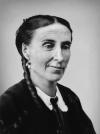Biography
Frances Browne was an Irish poet and novelist, best remembered for her collection of short stories for children: Granny's Wonderful Chair.
She was born at Stranorlar, in County Donegal, Ireland, the seventh child of twelve. She was blind from infancy as a consequence of an attack of smallpox when she was only 18 months old. In her writings, she recounts how she learned by heart the lessons which her brothers and sisters said aloud every evening, and how she bribed them to read to her by doing their chores. She then worked hard at memorising all that she had heard. She wrote her first poem, a version of "The Lord's Prayer", when she was seven years of age.
First publications
In 1841, her first poems were published in the Irish Penny Journal and in the London Athenauem. One of those included in the Irish Penny Journal was the beautiful lyric, "Songs of Our Land" which can be found in many anthologies of Irish patriotic verse. She published a complete volume of poems in 1844, and a second volume in 1847. The provincial newspapers, especially the Belfast-based Northern Whig reprinted many of her poems and she became widely known as 'The Blind Poetess of Ulster'. In 1845 she made her first contribution to the popular magazine Chambers's Journal and she wrote for this journal for the next 25 years. The first short story that she had published in the Journal was entitled, "The Lost New Year's Gift". It appeared in March 1845 and tells the tragic tale of a poor dressmaker in London. It displays Frances Browne's fine abilities as a storyteller. She also contributed many short stories to magazines that had a largely female readership. For example in the 1850's she made a number of contributions to the "Ladies' Companion", a magazine read by many well-to-do women of the Victorian era. Stories contributed to this magazine included the very amusing "Mrs Sloper's Swan" and an eerie tale set in Co.Fermanagh called "The Botheration of Ballymore."
Emigration to Edinburgh
In 1847, she left Donegal for Edinburgh with one of her sisters as her reader and amanuensis. She quickly established herself in literary circles, and wrote essays, reviews, stories, and poems, in spite of health problems. In 1852, she moved to London, where she wrote her first novel, My Share of the World (1861). Her most famous work, Granny's Wonderful Chair, was published in 1856 and it is still in print to this day. It is a richly imaginative book of fairy stories and has been translated into many languages. It was also in 1856 that her third volume of poetry appeared - Pictures and Songs of Home. It is a slim volume of poems directed at very young children and contains beautiful illustrations. As the title suggests the poems focus on her childhood experiences in County Donegal and they are very evocative of the Donegal countryside.
London and later life
After her move to London she wrote a lot for the Religious Tract Society making many contributions to their periodicals The Leisure Hour and The Sunday at Home. One of these was "1776: a tale of the American War of Independence" which was printed in The Leisure Hour on the centenary of that event in 1876. As well as describing some of the revolutionary events it is also a touching love story and is beautifully illustrated. Her last piece of writing was a poem called "The Children's Day" which appeared in "The Sunday at Home" in 1879.
She died unmarried at 19 St John's Grove in Richmond-upon-Thames on the 21st of August 1879 and was buried in the town's public cemetery on the 25th of August.
Further reading
The most detailed biography available is The Life and Works of Frances Browne by Patrick Bonar published in 2007. There is also an analysis of some of her short stories in an article in the Donegal Annual for 2008 - "Frances Browne and the Legends of Ulster" by Raymond Blair. Raymond Blair has also edited an anthology of her poems, short stories and essays entitled "The Best of Frances Browne." There is an excellent treatment of her literary career by Paul Marchbanks in An A-to-Z of Irish Women Writers edited by A G Gonzalez (2006). Finally a brief entry about the poetess can be found in the magisterial Dictionary of Irish Biography recently published under the auspices of the Royal Irish Academy. Therefore, it would appear that the fame of the undeservedly forgotten blind poetess is being gradually restored. ..






